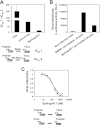Sphingopeptides: dihydrosphingosine-based fusion inhibitors against wild-type and enfuvirtide-resistant HIV-1
- PMID: 22872679
- PMCID: PMC3475257
- DOI: 10.1096/fj.12-215111
Sphingopeptides: dihydrosphingosine-based fusion inhibitors against wild-type and enfuvirtide-resistant HIV-1
Abstract
Understanding the structural organization of lipids in the cell and viral membranes is essential for elucidating mechanisms of viral fusion that lead to entry of enveloped viruses into their host cells. The HIV lipidome shows a remarkable enrichment in dihydrosphingomyelin, an unusual sphingolipid formed by a dihydrosphingosine backbone. Here we investigated the ability of dihydrosphingosine to incorporate into the site of membrane fusion mediated by the HIV envelope (Env) protein. Dihydrosphingosine as well as cholesterol, fatty acid, and tocopherol was conjugated to highly conserved, short HIV-1 Env-derived peptides with no antiviral activity otherwise. We showed that dihydrosphingosine exclusively endowed nanomolar antiviral activity to the peptides (IC(50) as low as 120 nM) in HIV-1 infection on TZM-bl cells and on Jurkat T cells, as well as in the cell-cell fusion assay. These sphingopeptides were active against enfuvirtide-resistant and wild-type CXCR4 and CCR5 tropic HIV strains. The anti-HIV activity was determined by both the peptides and their dihydrosphingosine conjugate. Moreover, their mode of action involved accumulation in the cells and viruses and binding to membranes enriched in sphingomyelin and cholesterol. The data suggest that sphingopeptides are recruited to the HIV membrane fusion site and provide a general concept in developing inhibitors of sphingolipid-mediated biological systems.
Figures





Similar articles
-
Artificial peptides conjugated with cholesterol and pocket-specific small molecules potently inhibit infection by laboratory-adapted and primary HIV-1 isolates and enfuvirtide-resistant HIV-1 strains.J Antimicrob Chemother. 2014 Jun;69(6):1537-45. doi: 10.1093/jac/dku010. Epub 2014 Feb 4. J Antimicrob Chemother. 2014. PMID: 24500189
-
Determinants of human immunodeficiency virus type 1 baseline susceptibility to the fusion inhibitors enfuvirtide and T-649 reside outside the peptide interaction site.J Virol. 2004 Jul;78(14):7582-9. doi: 10.1128/JVI.78.14.7582-7589.2004. J Virol. 2004. PMID: 15220433 Free PMC article.
-
Potent HIV fusion inhibitors against Enfuvirtide-resistant HIV-1 strains.Proc Natl Acad Sci U S A. 2008 Oct 21;105(42):16332-7. doi: 10.1073/pnas.0807335105. Epub 2008 Oct 13. Proc Natl Acad Sci U S A. 2008. PMID: 18852475 Free PMC article.
-
Resistance to enfuvirtide, the first HIV fusion inhibitor.J Antimicrob Chemother. 2004 Aug;54(2):333-40. doi: 10.1093/jac/dkh330. Epub 2004 Jul 1. J Antimicrob Chemother. 2004. PMID: 15231762 Review.
-
HIV entry inhibitors: mechanisms of action and resistance pathways.J Antimicrob Chemother. 2006 Apr;57(4):619-27. doi: 10.1093/jac/dkl027. Epub 2006 Feb 7. J Antimicrob Chemother. 2006. PMID: 16464888 Review.
Cited by
-
Early and late HIV-1 membrane fusion events are impaired by sphinganine lipidated peptides that target the fusion site.Biochem J. 2014 Jul 15;461(2):213-22. doi: 10.1042/BJ20140189. Biochem J. 2014. PMID: 24766462 Free PMC article.
-
Exceptional potency and structural basis of a T1249-derived lipopeptide fusion inhibitor against HIV-1, HIV-2, and simian immunodeficiency virus.J Biol Chem. 2018 Apr 6;293(14):5323-5334. doi: 10.1074/jbc.RA118.001729. Epub 2018 Feb 7. J Biol Chem. 2018. PMID: 29425101 Free PMC article.
-
Development of Protein- and Peptide-Based HIV Entry Inhibitors Targeting gp120 or gp41.Viruses. 2019 Aug 1;11(8):705. doi: 10.3390/v11080705. Viruses. 2019. PMID: 31374953 Free PMC article. Review.
-
Therapeutic Efficacy and Resistance Selection of a Lipopeptide Fusion Inhibitor in Simian Immunodeficiency Virus-Infected Rhesus Macaques.J Virol. 2020 Jul 16;94(15):e00384-20. doi: 10.1128/JVI.00384-20. Print 2020 Jul 16. J Virol. 2020. PMID: 32404526 Free PMC article.
-
Cholesterol-conjugated peptide antivirals: a path to a rapid response to emerging viral diseases.J Pept Sci. 2015 May;21(5):379-86. doi: 10.1002/psc.2706. Epub 2014 Oct 20. J Pept Sci. 2015. PMID: 25331523 Free PMC article. Review.
References
-
- White J. M. (1990) Viral and cellular membrane fusion proteins. Annu. Rev. Physiol. 52, 675–697 - PubMed
Publication types
MeSH terms
Substances
Grants and funding
LinkOut - more resources
Full Text Sources
Other Literature Sources

